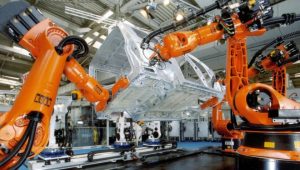
Industrial robots are an essential part of modern manufacturing. By implementing robots, you not only acquire state-of-the-art automation technology, but also get flexible and highly efficient production that is impressively reliable.
Often, the use of robots is the only sure way to survive in the current environment, and the choice of an industrial robot becomes the initial stage of future development.
So which robots are best? Which robot manufacturer should you choose?
There are dozens of industrial robots manufacturers around the world.

Many countries are trying to organize their own production of robots. For example, China is actively investing in the development of robotics. Even USA has recently taken its steps in this direction. But, of course, neither USA nor China will be able to influence the global trends in the development of robotics, at least for the next 20-30 years. There are a lot of recognized leaders, who develop at an incredible speed.
Who are the leaders of the global robotics industry? Let’s list a few:
- ABB (Sweden) – Kawasaki (Japan);
- Cloos (Germany) – KUKA (Germany);
- Fanuc (Japan- Motoman (Japan);
- IGM (Austria) – Panasonis (Japan).
The most important thing – auto manufacturers. Any auto manufacturer have to corporate agreements with one of the leading robot manufacturers. For example, Kawasaki industrial robots work in Toyota and Lexus factories; Fanuc robots are used at Audi and Volkswagen; KUKA robots serve Mercedes factories, and so on. To the question “Which robots are better?”, You will never get an answer.
The world leaders in robotics are developing dynamically. The laws of the market are very harsh. There is no room for error. As a PR or other campaign aimed at increasing interest in industrial robots, anyone can claim that the industrial robots they offer or use are the best.
Of course, Japanese manufacturers can be distinguished, since they are the undisputed leaders in terms of production and sales of industrial robots in the world. They play an important role in the development of world robotics, and directly influenced the course of history.
Some historical facts
Back in 1968, a historic event took place for the entire world of robotics: Kawasaki Heavy Industries released the first serial industrial robot and announced the beginning of a new era in industrial automation. But do not forget about European manufacturers such as KUKA, Cloos, ABB, IGM – all of them are worthy competition, in no way inferior to the Japanese. In fact, every robot manufacturer has a range to meet the current global demand for industrial automation. Some manufacturers create specialized series, “sharpened” for a specific technology. But, in general, all robots have a similar anthropomorphic design, approximately the same technical level and comparable build quality.
Which industrial robots to choose
For the end consumer it does not really matter which robots will be involved in his production. It is more important to choose the right robot integrator company, that will design and manufacture. It is important to know that industrial robots manufacturers do not sell their products to end consumers at all. They supply industrial robots using a distribution network in the form of integrator companies. It is the right choice of a system integrator , who specializes in the design and manufacture of robotic systems.
A system integrator who professionally implements robots to automate production processes is a company that designs and manufactures robotic systems, carries out installation supervision and commissioning, maintains the RTK, trains personnel, provides technical support, service, fulfills warranty obligations and accompanies the further development of industrial customer infrastructure.
The main task of the system integrator is the implementation of turnkey robotic technology. RTK must meet all the customer’s requirements, the integrator company together with the customer carry out a large amount of preparatory work, related to the creation of technical specifications, analysis of initial data, development of technical documentation and much more.
Industrial robots today
Today, industrial robots are becoming an integral part of modern production. Their use allows the creation of fully automated workplaces, sections, workshops, factories and factories, significantly increasing production efficiency.
If You want to robotize your process
Have you also made the decision to robotise one of the processes? Then take your time and read this article – it is for you. And it is not even so important what exactly you are going to raise to a new higher technical level. It is much more important not to be mistaken when choosing a supplier of this technology, where the main criterion is the competence of the future partner.
Having received preliminary information at the exhibition, and fascinated by the showroom where the industrial robot depicts some movements, the Customer signed a contract. However, subsequent technological problems that arose during the commissioning stage forced him to flee to court. On this, all the good undertakings for the introduction of an industrial robot ended. And it does not matter that in consequence, the lawsuit was won – the main result was the lack of robotic technology in production. Sad fact from real life …
For any enterprise in search, the most important task is not to be mistaken in the correct choice.
A little about competence:
Today in USA you can find a dozen companies that position themselves as System Integrators, ready to automate almost any production process by introducing an industrial robot into it.
Employees of such companies take an active part in various thematic Internet discussions, declaring themselves as a strong structure capable of solving any assigned tasks. They use PR campaigns aimed at increasing interest in themselves, and even take part in exhibitions, investing heavily in such projects. As a rule, the source of income for such organizations is trade (wholesale), and System Integration using robots is just a new project that requires significant funds, and most importantly – special knowledge for development.
This is commendable: many are trying to master and curb a new market for themselves. But the reality is harsh enough. System Integration using robotic technologies is not trade. Simple buy-and-sell laws don’t work here.
The successful implementation of an industrial robot requires unique knowledge, and most importantly, extensive experience in the implementation of such projects.
We will not classify domestic companies according to their level of competence and determine the level of their technological capabilities.
It is much more important to give effective advice on choosing a future partner who is ready to implement an industrial robot in your production:
Tip # 1: Don’t try to contract directly with a robot manufacturer. The manufacturer of robots never sells them to the end consumer. All sales, warranty and service are provided by other companies, such as your future partner (System Integrator).
Tip # 2: Check out the completed projects of your future partner, try to get relevant video and photographic materials. But be careful! In the absence of their own successful projects, many offer other people’s (or corporate) photos and videos about robotic complexes (RTC) around the world. This method is a cheap PR, which is very dangerous for the end consumer, since it is aimed at obtaining an order at any cost, without thinking about the consequences.
Tip # 3: Make sure that your future partner has the necessary experience in implementing an industrial robot in a specific technology that interests you. A simple example: automation of arc and resistance welding are two different technologies, each of which requires special (unique) knowledge.
If your partner does not have experience in creating similar Robotic Complexes, we strongly advise you not to experiment.
Tip # 4: Don’t send out a request or technical task for everyone. This may lead to the receipt of an unqualified proposal, which in the future will have a bad effect.
Use tips # 1, 2, and 3 and create a list of potential partners consisting of two to three companies. After receiving offers from them, make your choice.
Conclusion
The more portfolio of completed projects your future partner has, the higher your chances of success are. Trust not words and PR, but the experience embodied in the creation of Robotic Complexes.




